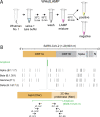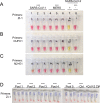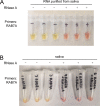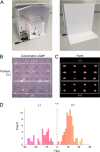WHotLAMP: A simple, inexpensive, and sensitive molecular test for the detection of SARS-CoV-2 in saliva
- PMID: 34529736
- PMCID: PMC8445428
- DOI: 10.1371/journal.pone.0257464
WHotLAMP: A simple, inexpensive, and sensitive molecular test for the detection of SARS-CoV-2 in saliva
Abstract
Despite the development of effective vaccines against SARS-CoV-2, epidemiological control of the virus is still challenging due to slow vaccine rollouts, incomplete vaccine protection to current and emerging variants, and unwillingness to get vaccinated. Therefore, frequent testing of individuals to identify early SARS-CoV-2 infections, contact-tracing and isolation strategies remain crucial to mitigate viral spread. Here, we describe WHotLAMP, a rapid molecular test to detect SARS-CoV-2 in saliva. WHotLAMP is simple to use, highly sensitive (~4 viral particles per microliter of saliva) and specific, as well as inexpensive, making it ideal for frequent screening. Moreover, WHotLAMP does not require toxic chemicals or specialized equipment and thus can be performed in point-of-care settings, and may also be adapted for resource-limited environments or home use. While applied here to SARS-CoV-2, WHotLAMP can be modified to detect other pathogens, making it adaptable for other diagnostic assays, including for use in future outbreaks.
Conflict of interest statement
Patent application 63/088,694 related to this technology was filed by Columbia University, to facilitate that this technology be made widely available. AB became a member of the advisory board of Rapid Diagnostic Systems Limited for which he received options, after the conclusion of experiments and data analyses described here. This does not alter our adherence to PLOS ONE policies on sharing data and materials.
Figures






Similar articles
-
Development of a Diagnostic Microfluidic Chip for SARS-CoV-2 Detection in Saliva and Nasopharyngeal Samples.Viruses. 2024 Jul 25;16(8):1190. doi: 10.3390/v16081190. Viruses. 2024. PMID: 39205164 Free PMC article.
-
Effectiveness and cost-effectiveness of four different strategies for SARS-CoV-2 surveillance in the general population (CoV-Surv Study): a structured summary of a study protocol for a cluster-randomised, two-factorial controlled trial.Trials. 2021 Jan 8;22(1):39. doi: 10.1186/s13063-020-04982-z. Trials. 2021. PMID: 33419461 Free PMC article.
-
Direct Detection of SARS-CoV-2 RNA in Saliva with Colorimetric RT-LAMP.Methods Mol Biol. 2024;2822:39-50. doi: 10.1007/978-1-0716-3918-4_4. Methods Mol Biol. 2024. PMID: 38907910
-
Molecular Diagnostic Tools for the Detection of SARS-CoV-2.Int Rev Immunol. 2021;40(1-2):143-156. doi: 10.1080/08830185.2020.1871477. Epub 2021 Jan 13. Int Rev Immunol. 2021. PMID: 33439059 Review.
-
Diagnosis of SARS-CoV-2 by RT-PCR Using Different Sample Sources: Review of the Literature.Ear Nose Throat J. 2021 Apr;100(2_suppl):131S-138S. doi: 10.1177/0145561320953231. Epub 2020 Aug 31. Ear Nose Throat J. 2021. PMID: 32865458 Free PMC article. Review.
Cited by
-
Hyris bCUBE SARS-CoV-2 rapid molecular saliva testing: a POCT innovation on its way.Clin Chem Lab Med. 2022 Jan 18;60(5):766-770. doi: 10.1515/cclm-2022-0008. Print 2022 Apr 26. Clin Chem Lab Med. 2022. PMID: 35041302
References
Publication types
MeSH terms
Substances
Grants and funding
LinkOut - more resources
Full Text Sources
Other Literature Sources
Medical
Miscellaneous

